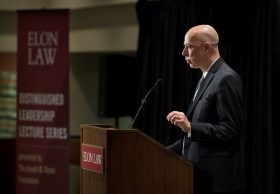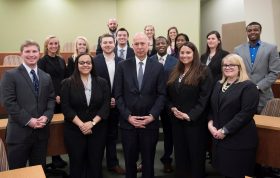The New York Times Supreme Court Correspondent told a February 9 public audience at Elon Law that a single change in the composition of the U.S. Supreme Court could change the fabric of American life.

Introducing Liptak, Professor Enrique Armijo described Liptak as, “The country’s preeminent explainer of both the work of the Supreme Court and the rest of the judicial branch, and that work’s effects on all of our lives.”
Reflecting on the first ten terms of the Supreme Court under Chief Justice John Roberts, Liptak said the Court was divided along partisan lines unlike any time in U.S. history.
“Presidents seem to have unlocked the secret to making sure that their nominees vote as the president might like them to vote,” Liptak said. “There’s never been a five to four split like this before. It is for the first time in American history, closely divided along partisan lines. Every one of the Court’s five more conservative members was appointed by Republican presidents and every one of its more liberal members was appointed by a Democratic president. It wasn’t long ago that party affiliation did not predict voting on the Supreme Court.”
While at Elon Law, Liptak finalized a New York Times article about the Supreme Court’s February 9 decision blocking an Obama administration regulation to reduce carbon emissions.
“You see just tonight in this 5-4 decision blocking a very significant climate change plan of a Democratic president, you have the five Republican appointees lining up on one side and the four Democratic appointees lining up on the other,” Liptak said. “To shut down this program before any court has had a look at it is some evidence that the right may be ascending again. The justices like to say that they are above politics, and I like to believe them when I can, but some of the evidence seems to point in a different direction.”

“The court likes to insist that it is not a political institution, and such a decision would have sent a different kind of signal,” Liptak said of the scenario in which the court would have declared major portions of the Affordable Care Act unconstitutional.
Not only is the Supreme Court more partisan, it has also shifted in a more conservative direction, Liptak said. Of the four most recent appointments to the court, three replaced a conservative for a conservative or a liberal for a liberal, but the 2006 appointment of Justice Samuel Alito, a conservative, for the retiring Justice Sandra Day O’Connor, a moderate, moved the court ideologically.
“That single move tugged the court to the right,” Liptak said. “It has changed the course of the court’s jurisprudence on abortion, on race, on campaign finance, on the rights of criminal defendants. It gives you a sense of how important this coming presidential election is. Anybody who gets to replace Justice Kennedy changes the fabric of American life. Any Republican who gets to replace Justices Breyer or Ginsburg, same thing. Any Democrat who gets to replace Justice Scalia, same thing. These differences really matter.”
Liptak said the Supreme Court’s upcoming term included major cases impacting abortion, immigration, affirmative action, voting rights, public unions and the clash between contraception and religious freedom. He suggested the court’s partisan divide may indicate conservative outcomes in many pending cases and that the justices would, by necessity, draw on their broader views, beyond strict interpretation of prior precedent, in determining major cases.
“There is really no question but that they array themselves in these 5-4 configurations,” Liptak said. “If all we cared about was law, we wouldn’t be fighting over Supreme Court nominations as viciously as we are fighting over them. If all we cared about was law, we wouldn’t have Supreme Court justices strategically planning their retirement to make sure they leave under a president whose politics they like.”
Liptak described the importance of timing in the Supreme Court’s decisions, noting that the justices had chosen to wait in taking a case in which they affirmed the right to same-sex marriage. He said the court’s decision to wait provided time for 37 states to adopt same-sex marriage laws before the court made its historic decision, leading to less political upheaval from their decision.
“Who would have thought a decade ago that we would have a constitutional right to same-sex marriage imposed nationwide by the United States Supreme Court and everyone takes it in stride,” Liptak asked.
While recognizing that the Supreme Court is more diverse in many ways, including three women for the first time in history, the first Hispanic justice and only the second African-American justice in the court’s history, Liptak raised questions about the limited educational and experiential backgrounds of the justices.
“Every single justice attended either Harvard or Yale law school,” Liptak said, noting that Justice Ginsburg started at Harvard but graduated from Columbia Law School. “That one fact gives the court a clubby, insular, elitist cast.”
He noted that none of the justices had broad experience beyond work as a lawyer or judge.
“Do we want this kind of highly trained technical lawyer or de we want someone with broader life experiences,” Liptak asked. “It’s true that the current court exhibits a high sheen of legal craft.”
Liptak pondered whether the historic Brown v. Board of Education decision would have been written without justices who had broader life experiences, including justices Earl Warren, Hugo Black and Robert Jackson.
“Does diversity in this sense matter,” Liptak said, asking whether the court would be different in its decisions with “people who bring not only the logic of law, but the light of human experience to the experience of judging on the Supreme Court.”
Adam Liptak covers the Supreme Court for The New York Times. His column on legal affairs, “Sidebar,” appears every other Tuesday. A graduate of Yale College and Yale Law School, Liptak worked during law school as a summer clerk in The New York Times Company’s legal department. After graduating, he spent four years at Cahill Gordon & Reindel, a large New York City law firm, as a litigation associate specializing in First Amendment matters.
Liptak returned to The Times’ legal department in 1992, spending a decade advising The Times and the company’s other newspapers, television stations and new media properties on defamation, privacy, newsgathering and related issues, and he frequently litigated media and commercial cases.
Liptak joined the paper’s news staff in 2002. He was a finalist for the Pulitzer Prize in explanatory reporting in 2009 for “American Exception,” a series of articles examining ways in which the American legal system differs from those of other developed nations. He received the 2010 Scripps Howard Award for Washington reporting for a five-part series on the Roberts court.
Liptak has written several law review articles, generally on First Amendment topics. He was awarded Hofstra University’s Presidential Medal and an honorary doctorate from Stetson University College of Law. He is a visiting lecturer at the University of Chicago Law School and has taught courses on media law and the Supreme Court at Columbia University, University of California, Los Angeles, University of Southern California and Yale.
The Distinguished Leadership Lecture Series presented by The Joseph M. Bryan Foundation is an integral part of Elon Law’s commitment to learning, lawyering and leadership.
Elon University School of Law is leading innovation in legal education by integrating traditional classroom instruction with highly experiential full-time residencies-in-practice in a logically sequenced program of professional preparation. This unique approach to legal education provides graduates with the knowledge, skills and ethics focus necessary to excel as 21st century lawyers. Designed to accelerate professional maturation, Elon Law’s groundbreaking approach is accomplished in two and one-half years, which provides distinctive value by lowering tuition and permitting graduates early entry into their professional careers. Learn more on Facebook, Twitter and the Elon Law website.


